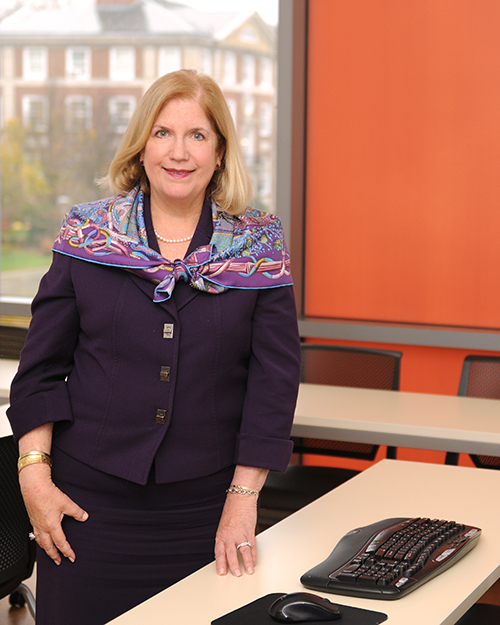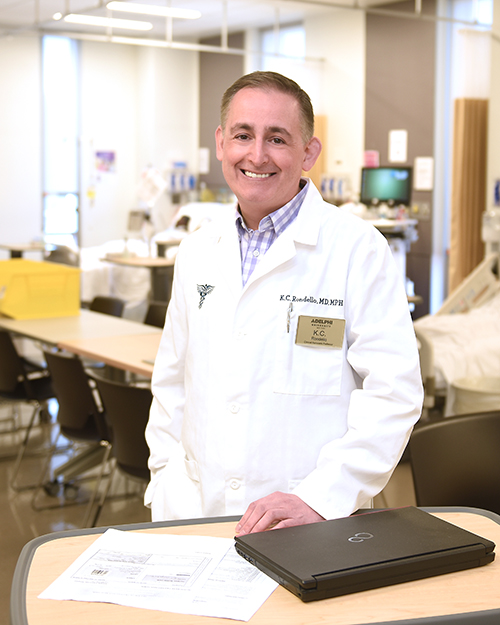
Adelphi's nursing and business schools join forces to inspire the next generation of nurse managers.
Can a framework for understanding leadership skills in the business world be useful for nurses? One interdisciplinary research team at Adelphi University—including three faculty members from the College of Nursing and Public Health and two from the Robert B. Willumstad School of Business—decided to investigate.
Their research produced “A Bridge to Leadership Communication Success: Impact of Leader-Member Exchange on Nursing Administrative Relationships,” published in the December 2019 issue of Nurse Leader. The authors included Patricia Donohue-Porter ’74, MS ’78, PhD ’87, associate professor and director of the College of Nursing and Public Health PhD program; Patricia Eckardt, PhD, professor at Molloy College; David Prottas, PhD, associate professor of management; K.C. Rondello, MD, clinical associate professor in the College of Nursing and Public Health; and Joyce Silberstang, PhD, former associate professor of management.

Patricia Donohue-Porter ’74, MS ’78, PhD ’87, focuses her research on nursing management and patient safety, particularly in the administration of medication.
Most existing research about nurse leaders had focused on individual characteristics, and not much attention was paid to the relationships these leaders maintain with their staff members. How, the team wondered, do these relationships impact values like organizational commitment and job satisfaction?
To find out, they turned to leader-member exchange (LMX) theory, an approach usually used to examine leadership in business settings. LMX theory centers on the interactions between managers and those who report to them. When LMX is high, employees report greater job satisfaction, open communication and autonomy.
Dr. Donohue-Porter believes LMX can be a valuable tool in nursing, where managers often lack experience in supervising a staff. “Nurse leaders in hospitals attain their positions because they are wonderful clinicians,” she said. “It’s not surprising to find nursing managers who were not trained in management and leadership skills.”

David Prottas, PhD, researches issues of self-employment, independent contracting and alternative work arrangements and the interrelationships between work and family.
The team surveyed a 600-bed hospital, providing its nurses, nurse managers and nurse administrators with mail-in surveys to measure—among other things—job satisfaction, organizational commitment and organizational citizenship behavior. They predicted that all three components would be higher among the nurses who reported having a better relationship with their immediate supervisor.
The mail-in survey and a subsequent series of six in-person interview sessions resulted in 206 responses: a 34 percent response rate. As predicted, a better perception of the staff member’s relationship with their supervisor correlated with both job satisfaction and organizational commitment. But, surprisingly, there was no significant correlation with organizational citizenship behavior or willingness to perform tasks that are not part of contractual duties. “This could be related to how nurses are socialized into the profession,” Dr. Donohue-Porter explained. “The service orientation of nurses may lend itself to ingrained organizational citizenship behavior despite the quality of their relationship with their managers.”

Kenneth C. Rondello, MD, specializes in disaster epidemiology and alternative distribution and dispensation of medical treatment. He has been a frequent source of information for the media during the COVID-19 crisis.
The team came together as part of a strategic research plan for increased interdisciplinary work within the College of Nursing and Public Health. An Adelphi University Faculty Development Grant, administered by the Office of the Provost, funded part of the research. “Some of the most important research at the University right now has a multidisciplinary framework,” said Provost and Executive Vice President Steve Everett, DMA, who believes such collaborations are “the model of the future.”
“The collaboration between the College of Nursing and Public Health and the Willumstad School of Business is important because outstanding nursing teamwork is essential to both effective patient care and workplace outcomes,” Dr. Donohue-Porter said. “Team cohesion does not always come naturally, and it can be more fully understood through interdisciplinary knowledge of nursing and management.”
Dr. Rondello agrees. “Cross-disciplinary collaboration isn’t an abstract construct in patient care,” he said. “We’re living it every day. That’s why it’s so critical for there to be interdisciplinary partnership in academia—since it informs decisions that lead to optimal patient outcomes in the real world.”
Because Nurse Leader is read by nurses who are currently in—or aspiring to—leadership positions at their institutions, Dr. Donohue-Porter calls it the “perfect place” for her team’s research. She hopes it will inspire the next generation of nurse managers to spend time honing their management skills and building strong relationships with their teams.
Donohue-Porter, Patricia, Patricia Eckardt, David Prottas, Kenneth C. Rondello, and Joyce Silberstang. “A Bridge to Leadership Communication Success: Impact of Leader-Member Exchange on Nursing Administrative Relationships.” Nurse Leader, vol. 17, iss. 6, December 2019, pp. 546-51.